Tech
How MIT ended up on Memorial Drive
Published
2 years agoon
By
Terry Power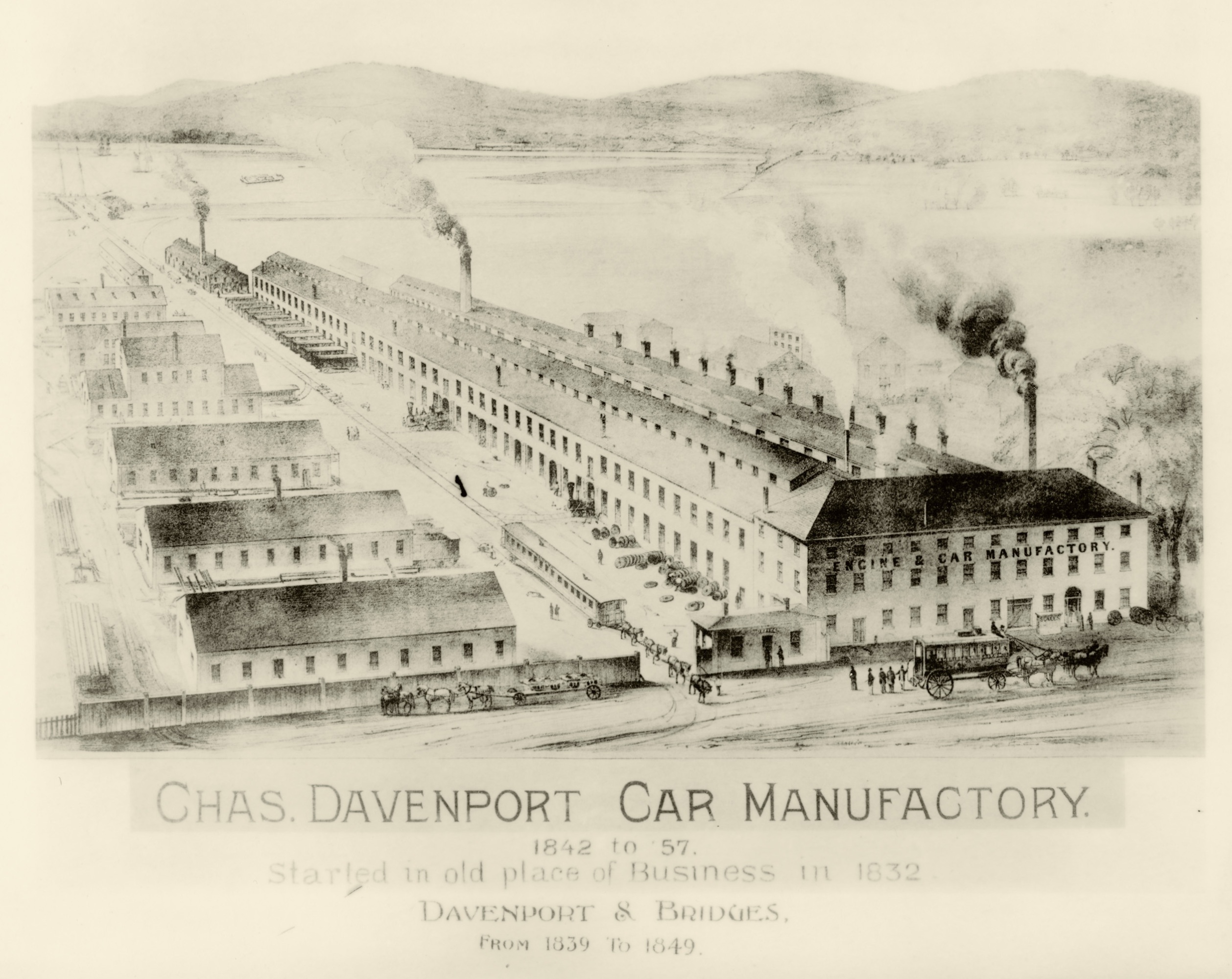
On March 23, 1912, the very day the subway connecting Boston and Cambridge opened to the public, another event took place that would change Kendall Square even more profoundly than the new, state-of-the-art transit system. As fate would have it, that was the day when a large swath of property adjacent to the square was formally conveyed to MIT, paving the way for the school’s move across the river from the Back Bay.
The Massachusetts Institute of Technology today forms such an essential part of Kendall Square—intertwined with the very definition of what the square is—that it may seem surprising to learn that the Institute’s arrival was by no means certain. In fact, if an enterprising businessman named Charles Davenport had realized his vision for the marshland on the banks of the Charles River, it’s very unlikely that the university would have come to Cambridge at all.
Davenport had started out as a woodworker’s apprentice, got into the coach-making business, and ultimately sold his pioneering railcar-making operation at 700 Main Street in 1855. But he remained extremely interested in what was going on around what was then called Dock Square, even as he traveled throughout the United States, took several trips to Europe, and made at least one sojourn to Cuba. During a visit to Havana in the 1850s, Davenport got the inspiration for developing the shoreline on both sides of the Charles River into a vast park. In Cuba’s capital, the former wheelwright “saw the small embankment on the bay there, where the people sat under the palms, enjoying the breezes.” That made him think of the Charles River and the salt marshes and mudflats that lined it on both sides. He envisioned “a boulevard along each river bank … two hundred feet in width,” and a stately residential district occupying much of the area where MIT now stands, to mirror that of Boston’s Back Bay.
Davenport already owned some of the marshland on the Cambridge side of the river. Upon returning to Boston, he began buying up more. He eventually accumulated three-fourths of the shoreline flats between the Cottage Farm and West Boston bridges (now the Boston University and Longfellow bridges, respectively), a roughly 2.5-mile stretch on the Cambridge side of the river. It was, essentially, the backyard of both his own former carriage works and Edward Kendall’s boiler-making operation.
The section of the Charles River around what is now Kendall Square had long been unappealing. In the 1800s, the Charles was dammed upriver for mills, and the bordering marshlands were filled for commercial and residential developments. At low tide, the lower Charles, including the area near Kendall Square, became a settling ground for sewage. By the mid-1800s, several plans had been advanced to fill the mudflats and marshes and make the Charles into a world-class public space and park system, but there had been little traction by the time Davenport got active—and he meant to change that.
Davenport formed the Charles River Embankment Company with some associates in 1880 to pursue his dream of creating Havana-like esplanades on both sides of the river. In Cambridge, his plans included a seawall or embankment that would protect the wide public esplanade and the line of grand homes to be constructed just inland. All this was imagined for just upriver from Dock Square, almost exactly where MIT now sits.
Davenport envisioned “a boulevard along each river bank … two hundred feet in width,” and a stately residential district occupying much of the area where MIT now stands, to mirror that of Boston’s Back Bay.
It almost happened—and there would almost certainly have been no MIT in Cambridge if it had. In 1882, the cities of Cambridge and Boston agreed to build a new bridge across the widest part of the river basin (this became the Harvard Bridge, along what was later named Massachusetts Avenue). The Embankment Company negotiated a deal. By giving up the land the city needed for an approach to the bridge and for a 200-foot-wide esplanade, it received a postponement of any tax increases on the rest of its land during construction—and permission to develop it. This arrangement, says Cambridge historian Charles Sullivan, gave the company “the right to build a seawall, construct what’s now Memorial Drive, and fill all the land where MIT is now.”
Construction of the seawall began in 1883, and the Harvard Bridge was completed in 1892. The Embankment Company hired architect Frederick Viaux to draw up plans for an upscale residential neighborhood behind the esplanade, extending all the way back to the railroad track embankment that Davenport himself had helped build in the 1850s. Developers would have to abide by certain restrictions—including a 20-foot setback from the esplanade, a prohibition against industrial or commercial structures, a requirement to use only brick, iron, or stone as building materials, and a minimum height of three stories and maximum height of eight.
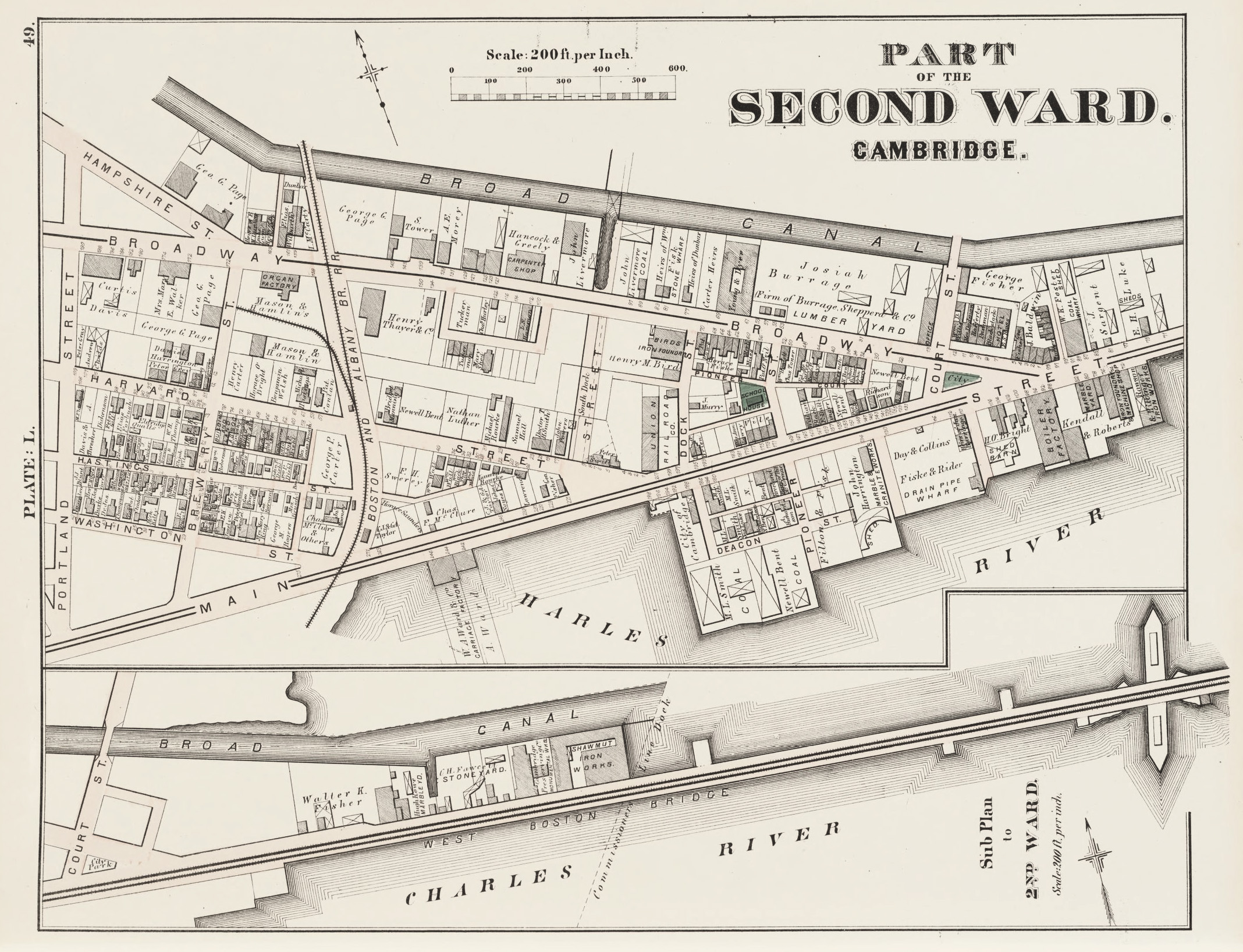
It all seemed compelling, but things started going haywire. More than 80% of the railroad tracks crossing Cambridge had been laid on a high embankment to protect the rails from the marshland below. The embankment had few culverts, severely cutting water flow from one side of the embankment to the other. That helped dry out the marshes north of the embankment and made them more suitable for development. But the river side of the rail line was still wet—and the marshlands reeked. By the late 1880s, an aging Davenport had essentially retired from business life. The Embankment Company he had helped form continued but found it hard to sell residential lots on that side, as the presence of the tracks discouraged many buyers.
Then came the devastating panic of 1893. The ensuing depression lasted until 1897 and forced the Embankment Company into bankruptcy. By then, a thousand feet of seawall had been constructed, and essentially all of the marshes and tide flats had been filled—creating solid land from Harvard Square all the way to East Cambridge. But little development took place for several years after the depression. By 1902, only the Riverbank Court Hotel at 305 Memorial Drive (now the MIT dorm Fariborz Maseeh Hall), the Metropolitan Storage Warehouse, the city armory (now MIT’s du Pont Athletic Center), and a smattering of other buildings had been completed. The lots Davenport’s group had envisioned for residential development sat unsold for the next 20 years, despite the expansive river and city views so appealing and sought after today.
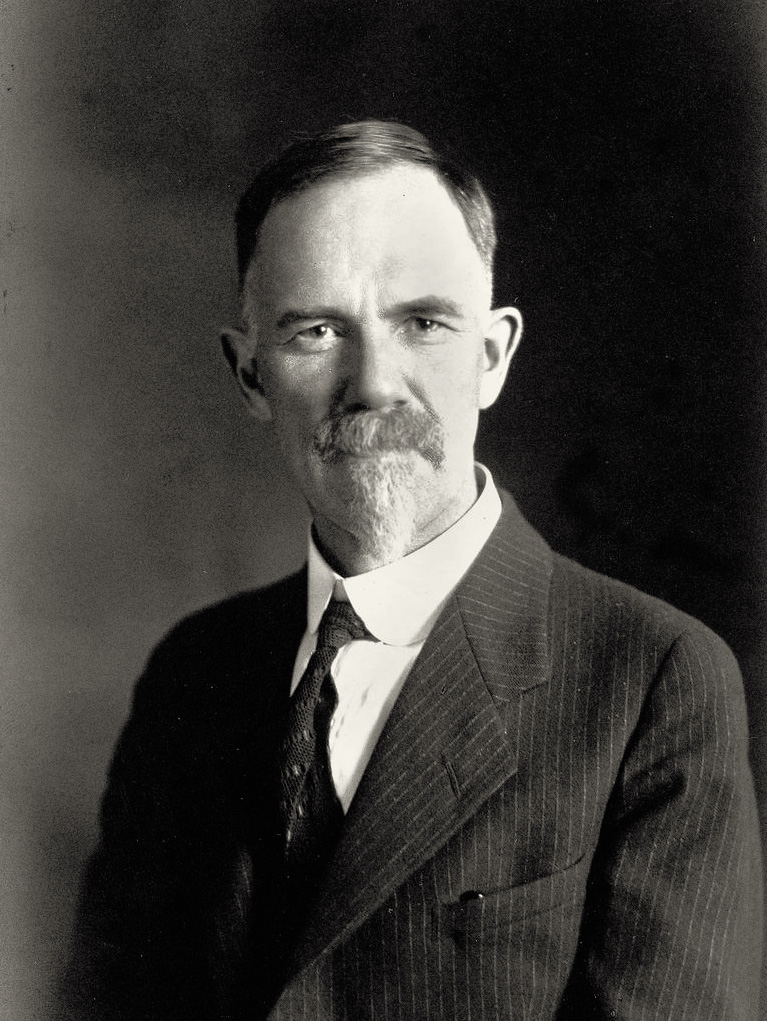
The failure of Davenport’s plan opened the door for the arrival of MIT. But it took an unlikely series of events to bring the already famous school to Cambridge in 1916. A few years earlier, in fact, the odds were great that MIT itself would not long exist as an independent entity: the plan had been for it to merge with Harvard as the foundation of a new science and engineering campus across the Charles River in Brighton, about where Harvard Business School is today. Powerful figures, including steel baron Andrew Carnegie, had stakes in making the union a reality.
The Massachusetts Institute of Technology had been chartered as a land-grant school in 1861. By the late 1800s, what many knew as Boston Tech had proved its worth as a top-flight engineering and applied science school, arguably the country’s best. Its popularity strained the limits of its tight quarters in Boston’s Back Bay. By the early 1900s, MIT was scouting for a new home.
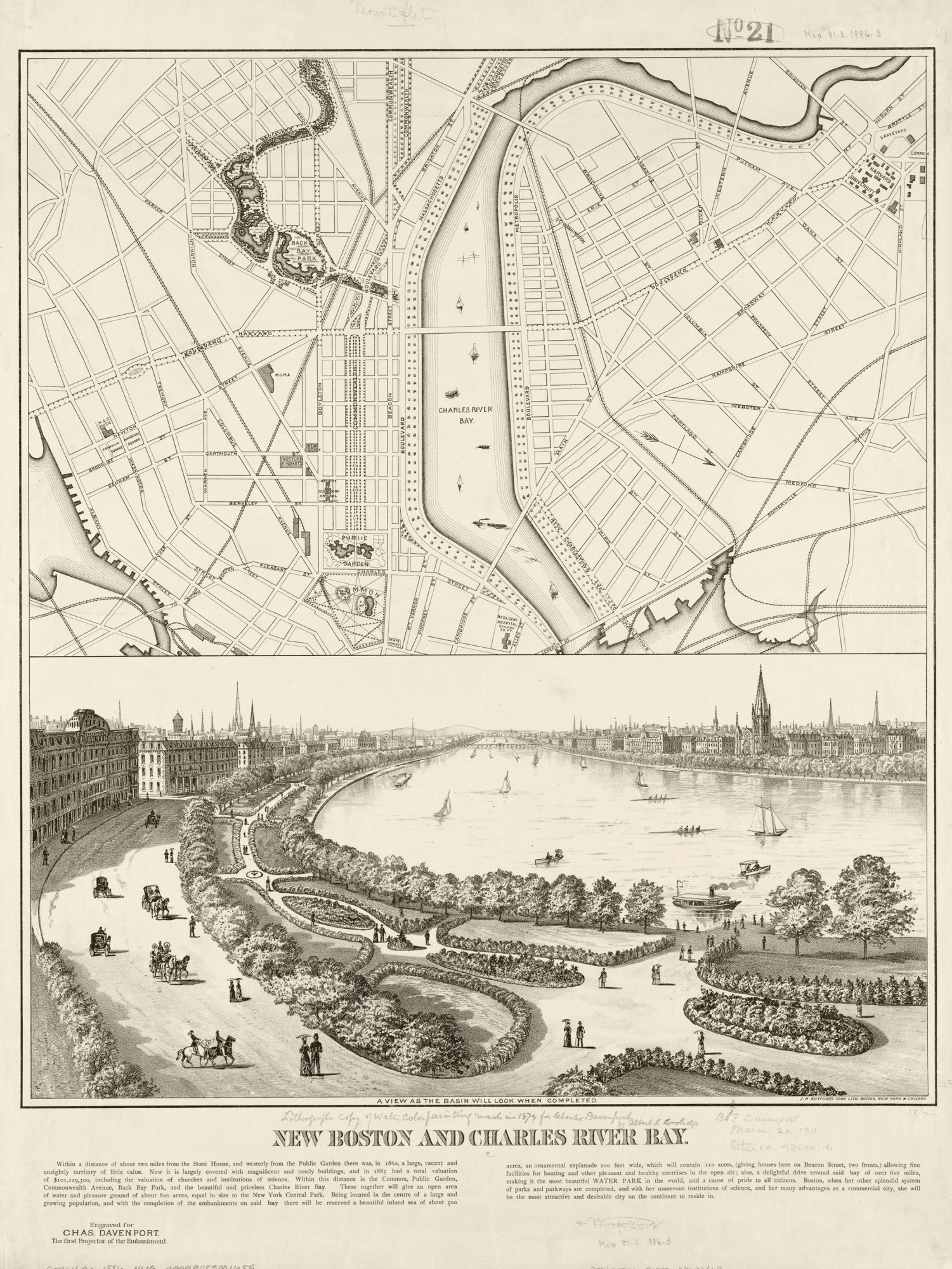
Harvard’s president, Charles Eliot, wanted that home to be Harvard. One of MIT’s inaugural chemistry professors, Eliot had become Harvard’s president in 1869. The Lawrence Scientific School, home to Harvard’s engineering and applied science program, was overshadowed by the college’s liberal arts reputation and struggled to attract enough students to justify its existence. So Eliot proposed to four successive presidents of Boston Tech that it and Harvard join forces. The fourth, Henry Pritchett, took the bait in the 1890s.
In January 1904, the Boston Daily Advertiser announced that Boston Tech and Harvard had agreed to merge. The surprise announcement set off a firestorm at MIT. While the agreement specified that the Institute would retain its name, charter, organization, and mission, the reality was that MIT would lose its cherished independence and become Harvard’s engineering school. That didn’t sit well with faculty, staff, or many alums. As one account summed up the concerns: “Should the Institute now, after nearly forty years’ struggle, give up its hard-won independence, sacrifice its fundamental principles, and yield a leadership won the hard way to come under the partial or complete domination of Harvard in the hope of monetary advantage?”
The answer from MIT faculty—by a vote of 56 to 7—was an overwhelming no. A survey sent to alumni showed 2,035 opposed and only 834 in favor. Nevertheless, in June 1905, the Technology Corporation gave the merger the green light by a vote of 23 to 15.
The union thus seemed ordained. In anticipation of the decision, a group of wealthy Harvard donors, including Andrew Carnegie and stockbroker Henry Higginson, had already pooled their resources and purchased the tract of riverfront property east of Soldiers Field in Brighton.
But there was one big catch. Under the terms of the agreement, MIT would be on the hook to “erect, furnish, and equip buildings having the capacity of at least its present buildings.” The school intended to sell all or part of its existing land in the Back Bay to fulfill this obligation. But in September 1905, only a few months after the Technology Corporation approved the plan, the Massachusetts Supreme Judicial Court ruled that since MIT had purchased its land with federal land-grant funding, it did not have the right to sell it. The union with Harvard fell through. Pritchett, who resigned as MIT president in 1907, is perhaps best known for the deal’s failure even today.
MIT resumed its search for a new campus. The university had already considered the Cambridge esplanade site that Charles Davenport had tried to develop and rejected it. But it was put back on the table under the new president who arrived in 1909—the Scottish-born, New Zealand–raised mathematician and lawyer Richard Maclaurin. Maclaurin “saw clearly that his first and most urgent task would be the relocation of MIT and the raising of funds to build the ‘New Technology,’” the name given to the envisioned new campus. (The existing one was known simply as Technology.)
Maclaurin’s eyes were on the Cambridge esplanade even before he officially started. On a visit to Boston in April 1909, a few months before he took office, the Scotsman dined at the Beacon Street home of Charles Stone, a founder of the then 20-year-old engineering firm Stone & Webster (both Stone and cofounder Edwin Webster were MIT grads). They looked out the windows over the Charles to the esplanade property. The incoming president was enamored. According to one MIT history, “This struck Maclaurin as ideal for size, accessibility, and dignity of setting. A great and noble edifice could here be erected that would be a worthy home for the Institute.” Stone told Maclaurin it had already been ruled out, explaining that Cambridge would likely oppose another tax-exempt university inside its borders, that Harvard would probably object, and that several would-be donors—he must have been thinking of Higginson, Carnegie, and their partners—were unlikely to give generously to support a move to that site after the failed merger.
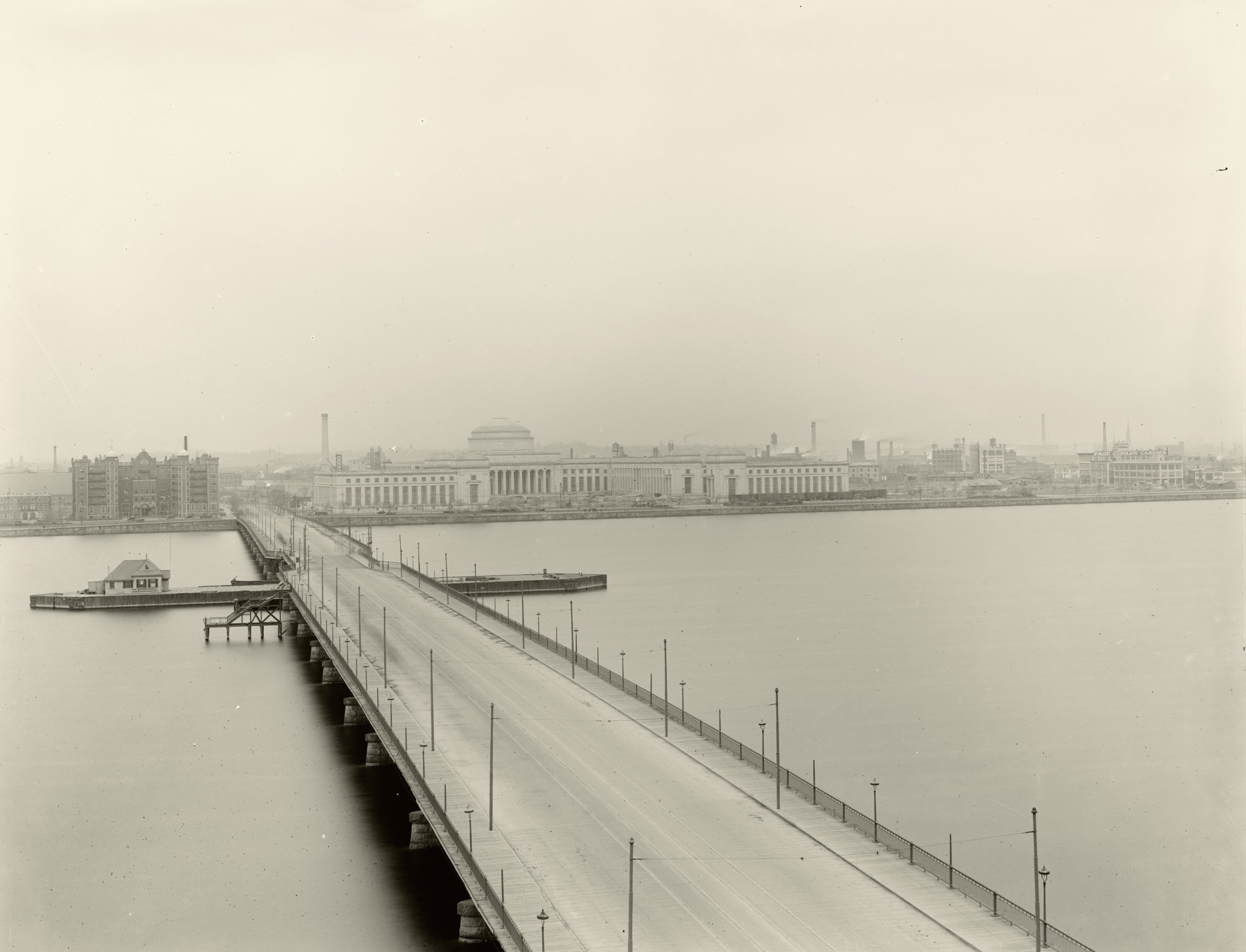
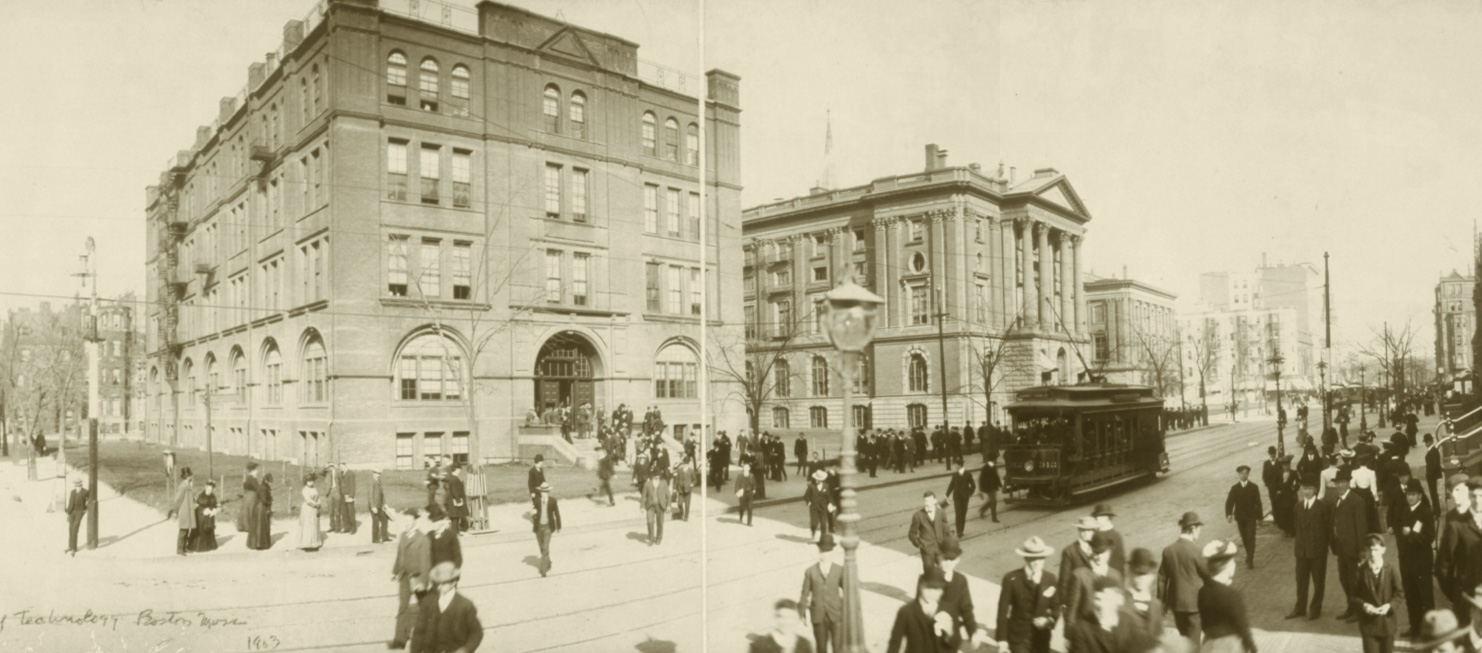
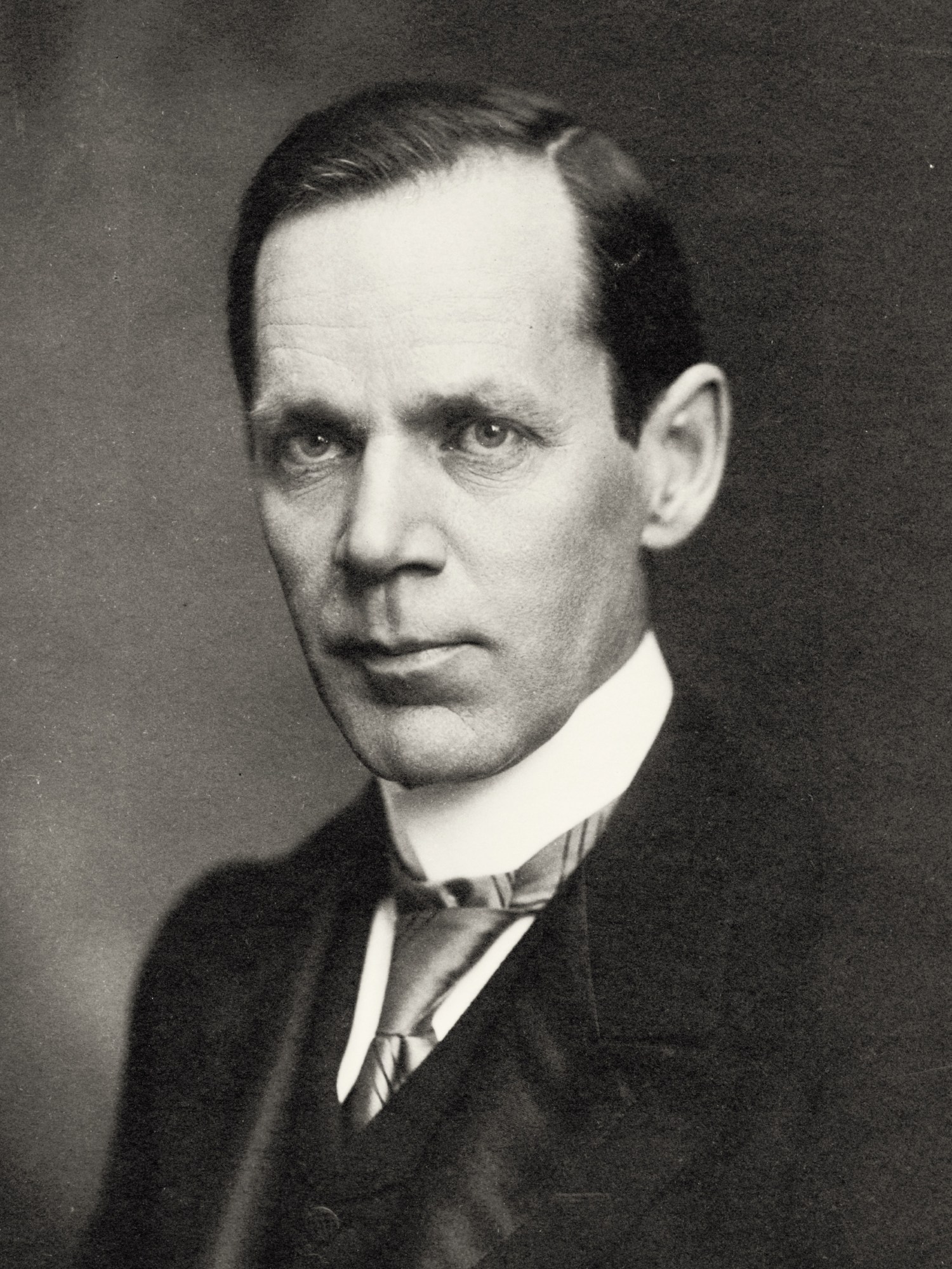
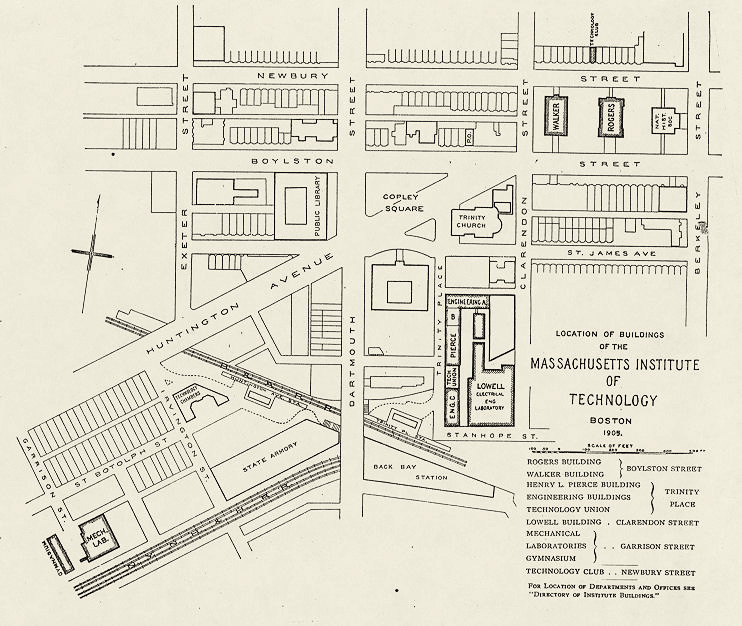
Maclaurin was not dissuaded. A formal new hunt for an expansion site launched with four main criteria: accessibility for students, faculty, and the public; affordability; space, with the potential for constructing buildings “worthy of the institute’s importance”; and a location “independent of the influence of other institutions.” The selection committee’s report, submitted to Maclaurin in October 1910, noted that the committee had considered at least 24 sites, even evaluating the possibility of building an island for the campus in the middle of the Charles, where the Harvard Bridge crossed it (this was soon deemed impractical). The most promising was a long stretch in Boston’s Fenway/Longwood area near the current Harvard Medical School campus and Simmons College. The esplanade site, called the Riverbank in the study, was a distant second, with a laundry list of potential problems. The report pointed out that the land was relatively costly and had a lot of owners—35, as it turned out—with whom to negotiate. The “encroaching manufacturing district” was deemed worrisome, as was the nearness to Harvard and that school’s potential objection to the move. Finally came the concerns about losing the school’s tax-exempt status.
In December, when Maclaurin tested the waters for a donation for any new site from Andrew Carnegie, “as Scotsman to Scotsman,” Carnegie turned him down flat: “Ye’re no blate. Just think of it, I hav given $3,800,000 towards extending the Pittsburg school … and you ask me to help Boston, which has received $400,000 from me for the Franklin Institute! I enjoy the joke! Besides, I do not put the Pittsburg school behind even the Massachusetts Institute of Technology. It is a close race and we’ll see who is winner by and by.” Carnegie even pushed again for the merger with Harvard in a blunt P.S.: “If I mistake not, I am a part owner of that ground that my friend Lee Higginson and some of us purchased to unite the two institutions, which should be done.”
Maclaurin did get a pledge of $500,000 from T. Coleman du Pont, an MIT graduate and future US senator who was then president of his family’s namesake chemical business. But it was for a different site, a golf course in Allston. So perhaps in an effort to stir the pot, Maclaurin casually remarked to a newspaper reporter that “Technology might have to pull up stakes and move to someplace where the cost of living is within its means.”
Several Massachusetts cities quickly expressed their interest. A group of MIT alumni from Springfield offered land there, for example. Cities in other states weighed in as well. The Chicago Evening Post boasted: “We could support a ‘Boston Tech’ with our loose change, and we wouldn’t, like some cities we know of, have to search all the hinterland roundabout to find the money.”
The competition stirred officials in Cambridge to take action. “Restive at being rated as the only city in the state which Technology would never, never consider,” as Maclaurin’s biographer wrote, it dropped any objection to MIT’s retaining its tax-exempt status. The Cambridge City Council passed a formal resolution supporting the relocation, which was forwarded to Maclaurin by the mayor with his personal endorsement. In March 1911, Harvard notified Maclaurin it was now also okay with having both institutions in Cambridge.
All this helped vault the Riverbank property to the top of the list—and loosen purse strings. Du Pont amended his pledge to extend it to the Cambridge property, and the state legislature approved a bill authorizing a grant of $100,000 a year to MIT for 10 years if the school raised a similar amount itself. By the fall of 1911, negotiations had been completed with all 35 owners of the Riverbank area to buy 46 acres of land bounded by Massachusetts Avenue on the west and Ames Street on the east, Vassar Street inland or north, and the esplanade. The envisioned campus did not extend east past Ames Street toward Main Street, where the MIT Media Lab and the MIT Sloan School of Management, among other buildings, stand today. Similarly, the land southwest of Massachusetts Avenue—now home to Kresge Auditorium, many student dorms (including the converted Riverbank Court Hotel), and the athletic center—was not part of the initial purchase. The price tag for the 46 acres was $775,000.
Then, in early 1912, Maclaurin met with Eastman Kodak founder George Eastman (who was neither an MIT alum nor a Massachusetts resident) at the Hotel Belmont in New York. They reportedly had a warm and earnest conversation, in which the MIT president detailed the plans for New Technology. As Maclaurin’s wife, Alice, later related, “The ground was broken so completely in Mr. Eastman’s mind that my husband was astonished. When Mr. Eastman was about to leave, he suddenly asked: ‘What will it cost to put up the new buildings?’ My husband answered that it would cost about two and a half million dollars. Mr. Eastman said, ‘I’ll send you a draft.’” Eastman’s one stipulation was that he remain anonymous—and so he was referred to only as Mr. Smith until his identity was revealed in 1920.
Although conveyance of the property to MIT took place on March 23, 1912, the same day the subway line officially debuted, it would take another four years for the first wave of construction and other elements to come together to enable MIT’s move. But a new era was visible on the horizon.
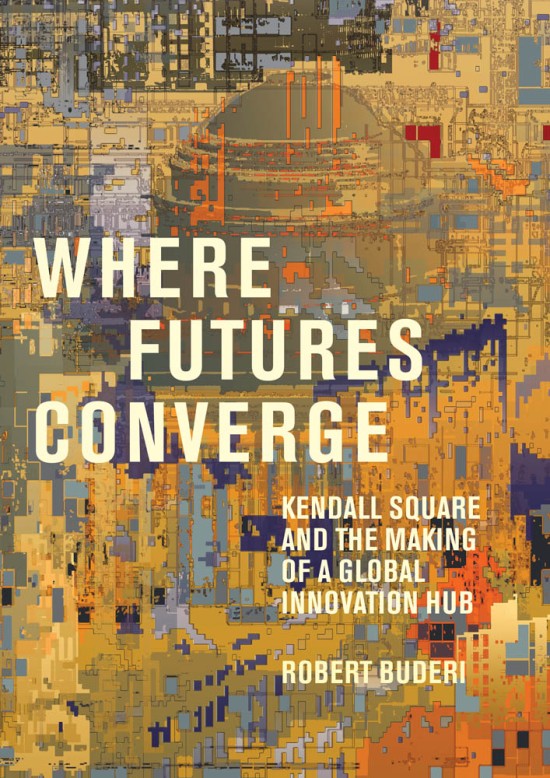
Where Futures Converge
Robert Buderi was editor at large and then editor in chief of Technology Review between 2000 and 2004. Excerpted from Where Futures Converge: Kendall Square and the Making of a Global Innovation Hub. Reprinted with permission from The MIT Press. Copyright 2022.
You may like
-


Introducing MIT Technology Review Roundtables, real-time conversations about what’s next in tech
-
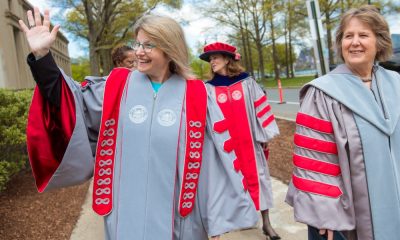

When MIT met Sally
-


Recent books from the MIT community
-


Improved Mental Health Among Teens Reported Before COVID-19 Pandemic Ended
-
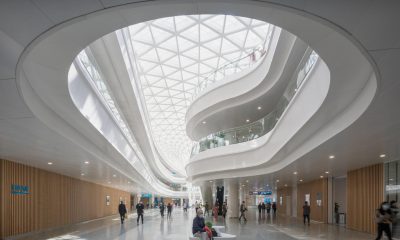

Digital transformation as a service is poised to drive enterprise growth
-


Infosys and SAP together drive business innovation for clients

My senior spring in high school, I decided to defer my MIT enrollment by a year. I had always planned to take a gap year, but after receiving the silver tube in the mail and seeing all my college-bound friends plan out their classes and dorm decor, I got cold feet. Every time I mentioned my plans, I was met with questions like “But what about school?” and “MIT is cool with this?”
Yeah. MIT totally is. Postponing your MIT start date is as simple as clicking a checkbox.
COURTESY PHOTO
Now, having finished my first year of classes, I’m really grateful that I stuck with my decision to delay MIT, as I realized that having a full year of unstructured time is a gift. I could let my creative juices run. Pick up hobbies for fun. Do cool things like work at an AI startup and teach myself how to create latte art. My favorite part of the year, however, was backpacking across Europe. I traveled through Austria, Slovakia, Russia, Spain, France, the UK, Greece, Italy, Germany, Poland, Romania, and Hungary.
Moreover, despite my fear that I’d be losing a valuable year, traveling turned out to be the most productive thing I could have done with my time. I got to explore different cultures, meet new people from all over the world, and gain unique perspectives that I couldn’t have gotten otherwise. My travels throughout Europe allowed me to leave my comfort zone and expand my understanding of the greater human experience.
“In Iceland there’s less focus on hustle culture, and this relaxed approach to work-life balance ends up fostering creativity. This was a wild revelation to a bunch of MIT students.”
When I became a full-time student last fall, I realized that StartLabs, the premier undergraduate entrepreneurship club on campus, gives MIT undergrads a similar opportunity to expand their horizons and experience new things. I immediately signed up. At StartLabs, we host fireside chats and ideathons throughout the year. But our flagship event is our annual TechTrek over spring break. In previous years, StartLabs has gone on TechTrek trips to Germany, Switzerland, and Israel. On these fully funded trips, StartLabs members have visited and collaborated with industry leaders, incubators, startups, and academic institutions. They take these treks both to connect with the global startup sphere and to build closer relationships within the club itself.
Most important, however, the process of organizing the TechTrek is itself an expedited introduction to entrepreneurship. The trip is entirely planned by StartLabs members; we figure out travel logistics, find sponsors, and then discover ways to optimize our funding.

COURTESY PHOTO
In organizing this year’s trip to Iceland, we had to learn how to delegate roles to all the planners and how to maintain morale when making this trip a reality seemed to be an impossible task. We woke up extra early to take 6 a.m. calls with Icelandic founders and sponsors. We came up with options for different levels of sponsorship, used pattern recognition to deduce the email addresses of hundreds of potential contacts at organizations we wanted to visit, and all got scrappy with utilizing our LinkedIn connections.
And as any good entrepreneur must, we had to learn how to be lean and maximize our resources. To stretch our food budget, we planned all our incubator and company visits around lunchtime in hopes of getting fed, played human Tetris as we fit 16 people into a six-person Airbnb, and emailed grocery stores to get their nearly expired foods for a discount. We even made a deal with the local bus company to give us free tickets in exchange for a story post on our Instagram account.
Tech
The Download: spying keyboard software, and why boring AI is best
Published
8 months agoon
22 August 2023By
Terry Power
This is today’s edition of The Download, our weekday newsletter that provides a daily dose of what’s going on in the world of technology.
How ubiquitous keyboard software puts hundreds of millions of Chinese users at risk
For millions of Chinese people, the first software they download onto devices is always the same: a keyboard app. Yet few of them are aware that it may make everything they type vulnerable to spying eyes.
QWERTY keyboards are inefficient as many Chinese characters share the same latinized spelling. As a result, many switch to smart, localized keyboard apps to save time and frustration. Today, over 800 million Chinese people use third-party keyboard apps on their PCs, laptops, and mobile phones.
But a recent report by the Citizen Lab, a University of Toronto–affiliated research group, revealed that Sogou, one of the most popular Chinese keyboard apps, had a massive security loophole. Read the full story.
—Zeyi Yang
Why we should all be rooting for boring AI
Earlier this month, the US Department of Defense announced it is setting up a Generative AI Task Force, aimed at “analyzing and integrating” AI tools such as large language models across the department. It hopes they could improve intelligence and operational planning.
But those might not be the right use cases, writes our senior AI reporter Melissa Heikkila. Generative AI tools, such as language models, are glitchy and unpredictable, and they make things up. They also have massive security vulnerabilities, privacy problems, and deeply ingrained biases.
Applying these technologies in high-stakes settings could lead to deadly accidents where it’s unclear who or what should be held responsible, or even why the problem occurred. The DoD’s best bet is to apply generative AI to more mundane things like Excel, email, or word processing. Read the full story.
This story is from The Algorithm, Melissa’s weekly newsletter giving you the inside track on all things AI. Sign up to receive it in your inbox every Monday.
The ice cores that will let us look 1.5 million years into the past
To better understand the role atmospheric carbon dioxide plays in Earth’s climate cycles, scientists have long turned to ice cores drilled in Antarctica, where snow layers accumulate and compact over hundreds of thousands of years, trapping samples of ancient air in a lattice of bubbles that serve as tiny time capsules.
By analyzing those cores, scientists can connect greenhouse-gas concentrations with temperatures going back 800,000 years. Now, a new European-led initiative hopes to eventually retrieve the oldest core yet, dating back 1.5 million years. But that impressive feat is still only the first step. Once they’ve done that, they’ll have to figure out how they’re going to extract the air from the ice. Read the full story.
—Christian Elliott
This story is from the latest edition of our print magazine, set to go live tomorrow. Subscribe today for as low as $8/month to ensure you receive full access to the new Ethics issue and in-depth stories on experimental drugs, AI assisted warfare, microfinance, and more.
The must-reads
I’ve combed the internet to find you today’s most fun/important/scary/fascinating stories about technology.
1 How AI got dragged into the culture wars
Fears about ‘woke’ AI fundamentally misunderstand how it works. Yet they’re gaining traction. (The Guardian)
+ Why it’s impossible to build an unbiased AI language model. (MIT Technology Review)
2 Researchers are racing to understand a new coronavirus variant
It’s unlikely to be cause for concern, but it shows this virus still has plenty of tricks up its sleeve. (Nature)
+ Covid hasn’t entirely gone away—here’s where we stand. (MIT Technology Review)
+ Why we can’t afford to stop monitoring it. (Ars Technica)
3 How Hilary became such a monster storm
Much of it is down to unusually hot sea surface temperatures. (Wired $)
+ The era of simultaneous climate disasters is here to stay. (Axios)
+ People are donning cooling vests so they can work through the heat. (Wired $)
4 Brain privacy is set to become important
Scientists are getting better at decoding our brain data. It’s surely only a matter of time before others want a peek. (The Atlantic $)
+ How your brain data could be used against you. (MIT Technology Review)
5 How Nvidia built such a big competitive advantage in AI chips
Today it accounts for 70% of all AI chip sales—and an even greater share for training generative models. (NYT $)
+ The chips it’s selling to China are less effective due to US export controls. (Ars Technica)
+ These simple design rules could turn the chip industry on its head. (MIT Technology Review)
6 Inside the complex world of dissociative identity disorder on TikTok
Reducing stigma is great, but doctors fear people are self-diagnosing or even imitating the disorder. (The Verge)
7 What TikTok might have to give up to keep operating in the US
This shows just how hollow the authorities’ purported data-collection concerns really are. (Forbes)
8 Soldiers in Ukraine are playing World of Tanks on their phones
It’s eerily similar to the war they are themselves fighting, but they say it helps them to dissociate from the horror. (NYT $)
9 Conspiracy theorists are sharing mad ideas on what causes wildfires
But it’s all just a convoluted way to try to avoid having to tackle climate change. (Slate $)
10 Christie’s accidentally leaked the location of tons of valuable art 

Seemingly thanks to the metadata that often automatically attaches to smartphone photos. (WP $)
Quote of the day
“Is it going to take people dying for something to move forward?”
—An anonymous air traffic controller warns that staffing shortages in their industry, plus other factors, are starting to threaten passenger safety, the New York Times reports.
The big story
Inside effective altruism, where the far future counts a lot more than the present

October 2022
Since its birth in the late 2000s, effective altruism has aimed to answer the question “How can those with means have the most impact on the world in a quantifiable way?”—and supplied methods for calculating the answer.
It’s no surprise that effective altruisms’ ideas have long faced criticism for reflecting white Western saviorism, alongside an avoidance of structural problems in favor of abstract math. And as believers pour even greater amounts of money into the movement’s increasingly sci-fi ideals, such charges are only intensifying. Read the full story.
—Rebecca Ackermann
We can still have nice things
A place for comfort, fun and distraction in these weird times. (Got any ideas? Drop me a line or tweet ’em at me.)
+ Watch Andrew Scott’s electrifying reading of the 1965 commencement address ‘Choose One of Five’ by Edith Sampson.
+ Here’s how Metallica makes sure its live performances ROCK. ($)
+ Cannot deal with this utterly ludicrous wooden vehicle.
+ Learn about a weird and wonderful new instrument called a harpejji.
Tech
Why we should all be rooting for boring AI
Published
8 months agoon
22 August 2023By
Terry Power
This story originally appeared in The Algorithm, our weekly newsletter on AI. To get stories like this in your inbox first, sign up here.
I’m back from a wholesome week off picking blueberries in a forest. So this story we published last week about the messy ethics of AI in warfare is just the antidote, bringing my blood pressure right back up again.
Arthur Holland Michel does a great job looking at the complicated and nuanced ethical questions around warfare and the military’s increasing use of artificial-intelligence tools. There are myriad ways AI could fail catastrophically or be abused in conflict situations, and there don’t seem to be any real rules constraining it yet. Holland Michel’s story illustrates how little there is to hold people accountable when things go wrong.
Last year I wrote about how the war in Ukraine kick-started a new boom in business for defense AI startups. The latest hype cycle has only added to that, as companies—and now the military too—race to embed generative AI in products and services.
Earlier this month, the US Department of Defense announced it is setting up a Generative AI Task Force, aimed at “analyzing and integrating” AI tools such as large language models across the department.
The department sees tons of potential to “improve intelligence, operational planning, and administrative and business processes.”
But Holland Michel’s story highlights why the first two use cases might be a bad idea. Generative AI tools, such as language models, are glitchy and unpredictable, and they make things up. They also have massive security vulnerabilities, privacy problems, and deeply ingrained biases.
Applying these technologies in high-stakes settings could lead to deadly accidents where it’s unclear who or what should be held responsible, or even why the problem occurred. Everyone agrees that humans should make the final call, but that is made harder by technology that acts unpredictably, especially in fast-moving conflict situations.
Some worry that the people lowest on the hierarchy will pay the highest price when things go wrong: “In the event of an accident—regardless of whether the human was wrong, the computer was wrong, or they were wrong together—the person who made the ‘decision’ will absorb the blame and protect everyone else along the chain of command from the full impact of accountability,” Holland Michel writes.
The only ones who seem likely to face no consequences when AI fails in war are the companies supplying the technology.
It helps companies when the rules the US has set to govern AI in warfare are mere recommendations, not laws. That makes it really hard to hold anyone accountable. Even the AI Act, the EU’s sweeping upcoming regulation for high-risk AI systems, exempts military uses, which arguably are the highest-risk applications of them all.
While everyone is looking for exciting new uses for generative AI, I personally can’t wait for it to become boring.
Amid early signs that people are starting to lose interest in the technology, companies might find that these sorts of tools are better suited for mundane, low-risk applications than solving humanity’s biggest problems.
Applying AI in, for example, productivity software such as Excel, email, or word processing might not be the sexiest idea, but compared to warfare it’s a relatively low-stakes application, and simple enough to have the potential to actually work as advertised. It could help us do the tedious bits of our jobs faster and better.
Boring AI is unlikely to break as easily and, most important, won’t kill anyone. Hopefully, soon we’ll forget we’re interacting with AI at all. (It wasn’t that long ago when machine translation was an exciting new thing in AI. Now most people don’t even think about its role in powering Google Translate.)
That’s why I’m more confident that organizations like the DoD will find success applying generative AI in administrative and business processes.
Boring AI is not morally complex. It’s not magic. But it works.
Deeper Learning
AI isn’t great at decoding human emotions. So why are regulators targeting the tech?
Amid all the chatter about ChatGPT, artificial general intelligence, and the prospect of robots taking people’s jobs, regulators in the EU and the US have been ramping up warnings against AI and emotion recognition. Emotion recognition is the attempt to identify a person’s feelings or state of mind using AI analysis of video, facial images, or audio recordings.
But why is this a top concern? Western regulators are particularly concerned about China’s use of the technology, and its potential to enable social control. And there’s also evidence that it simply does not work properly. Tate Ryan-Mosley dissected the thorny questions around the technology in last week’s edition of The Technocrat, our weekly newsletter on tech policy.
Bits and Bytes
Meta is preparing to launch free code-generating software
A version of its new LLaMA 2 language model that is able to generate programming code will pose a stiff challenge to similar proprietary code-generating programs from rivals such as OpenAI, Microsoft, and Google. The open-source program is called Code Llama, and its launch is imminent, according to The Information. (The Information)
OpenAI is testing GPT-4 for content moderation
Using the language model to moderate online content could really help alleviate the mental toll content moderation takes on humans. OpenAI says it’s seen some promising first results, although the tech does not outperform highly trained humans. A lot of big, open questions remain, such as whether the tool can be attuned to different cultures and pick up context and nuance. (OpenAI)
Google is working on an AI assistant that offers life advice
The generative AI tools could function as a life coach, offering up ideas, planning instructions, and tutoring tips. (The New York Times)
Two tech luminaries have quit their jobs to build AI systems inspired by bees
Sakana, a new AI research lab, draws inspiration from the animal kingdom. Founded by two prominent industry researchers and former Googlers, the company plans to make multiple smaller AI models that work together, the idea being that a “swarm” of programs could be as powerful as a single large AI model. (Bloomberg)
